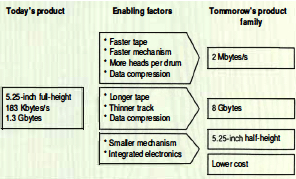History (1989): Hewlett-Packard First Big Computer Firm to Offer Data-DAT
$1,950 in Q1,000
By Jean Jacques Maleval | August 1, 2019 at 2:19 pmFor the first time, a major computer company is offering a Data-DAT, a low-cost device that can backup the equivalent of 1,000 to 2,000 floppy disks or sixty 20MB HDDs and based on the tiny 4mm helical scan recording tape cartridge known in the audio industry.
Hewlett-Packard Co. announced the HP 35450A Digital-Data-Storage (DDS) tape drive, its first digital audio tape (DAT) product for OEMs.

The specifications are about identical to those of the other units offered by Gigatape GmbH (Puchheim, West Germany), WangDAT Inc. (Costa Mesa, CAl, WangTek (Simi Valley, CAl or the Japanese, Hitachi, Mitsumi, Sharp or Sony.
The 5.25-inch form factor drive stores 1.3GB. It features a built-in SCSI controller, a 20s average access time due to a fast-search facility that operates lip to 200 times the normal R/W speed and a transfer rate of 183KB/s, according to the company. 1.3GB can be backed up in less than two hours. The uncorrectable error rate is less than one in 105 bits with three levels of ECC and read-after-write features. The HP 35450A is projected to have an MTBF of more than 40,000 hours, mostly on account of a low tape speed, a build-in head cleaner and a way to maintain tape tension electronically rather than mechanically.
How HP’s DAT is manufactured and marketed?
HP will sell the OEM product for $1,950 in one thousand volume. A DAT cartridge costs about $10. Evaluation units of the HP 35450A drive are ready now and volume production is expected to begin in December 1989, “in Bristol at a rate of 2,000 units per month” said a spokesman of HP.
At a visit of the British plant, no manufacturing line for Data- DAT was in place. “We can quickly set one up,” he assured.
A second HP manufacturing source is scheduled in Greeley (CO), said Raymond A. Smemek, GM of HP mass storage business unit.
Peripherals Strategies (Santa Barbara, CA), a consulting firm, estimates that 5,000 Data-DAT were sold in 1988 for a $2,500 unit price, and that 75,000 should be sold in 1990 for $ 1,500 and later 510,000 in 1993 for $653.
DAT/DDS potential
According to HP, opportunities exist for future products with faster transfer rates and higher capacities, as well as products with reduced form-factors and price. With no change in the DDS recording format, future generation DDS products could offer 8GB capacity per cartridge, with transfer rates over 2MB/s.

For the product, HP and the Japanese company announced a joint development in August 1 987. In Bristol, the US company will assemble a drive based on a Sony mechanism directly issued from audio DATs and blank printed circuit boards from HP in Grenoble (France). In fact, these boards will be sold back to Sony who will be OEMs. This removable media, the Data-DAT, caused a tenacious fight between two groups, the first one led by GigaTape (and Hitachi) and named Data-DAT Technical Committee, the second by HP with its DDS format.

“In March 1989,” said Bert Vermeulen, product marketing manager, HP computer peripherals Bristol. “The fourth draft was forwarded for approval by ANSI (American National Standards Institute) Committee X3B5 and ISO (International Standard Organization). More than 10 major companies publicly support DDS.”
He quoted Hewlett-Packard Co., Sony Corp., Alliance Technologies Inc. (Sunnyvale, CA), Archive Corp., Aiwa, Alps, Laser Magnetic Storage Inc. (a joint venture between Philips and Control Data in Colorado Springs, CO), Exabyte Corp. (Boulder, CO), Mitsumi, WangTek and Wang DAT.
Does this mean that GigaTape’s format was rejected by the ANSI? “No,” answered Vermeulen. “The ANSI could adopt the two formats as the Data-DAT format (GigaTape’s) is not as advanced in the standardization procedure.”
Data-DAT format is a more feature-rich and a more expansive alternative and is endorsed among other companies by Apple Computer (Cupertino, CA), Alps, Cipher Data Products (San Diego, CA), Fujitsu, GigaTape, Hitachi, Kenwood, JVC, Mitsumi, Panasonic, Sharp, TEAC and Toshiba. And if there are no license fees claimed by the German company, it’s not the same for HP who is asking for a lump sum payment of $10,000 and a $2 royalty per unit.
In storage architecture, HP considers the sequential DAT cartridge as a secondary removable storage for backing up on high-end PCs, workstations and entry-level multi-user systems, just after HDDs named primary storage and magneto-optical disks designated as direct access secondary storage.
Tape drive storage positioning

The new media will directly compete with actual longitudinal recording half-inch and quarter-inch cartridges. In the next future, Peter Green, marketing manager, HP computer peripherals Bristol, forecasts an 8GB DAT with a 2MB/s transfer rate on account of a longer tape, a thinner track, data compression, a faster mechanism and more heads per drum .
Form factor, actually 5.25-inch full height will go to a 3.5-inch full height tomorrow and the cost per unit should reduce.
At about the same time, Sony and WangDAT introduced DAT drives in conformity with the DDS standard. The Sony drive is priced around $2,000 and the Wang DAT one $ 1,595 in OEM quantities.
This article is an abstract of news published on the former paper version of Computer Data Storage Newsletter on issue ≠16, published on May 1989.













 Subscribe to our free daily newsletter
Subscribe to our free daily newsletter

